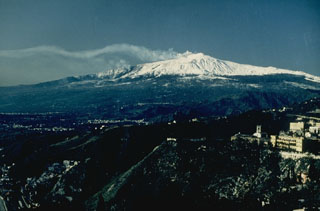Report on Etna (Italy) — 1 March-7 March 2017
Smithsonian Institution / US Geological Survey
Weekly Volcanic Activity Report, 1 March-7 March 2017
Managing Editor: Sally Sennert.
Please cite this report as:
Global Volcanism Program, 2017. Report on Etna (Italy) (Sennert, S, ed.). Weekly Volcanic Activity Report, 1 March-7 March 2017. Smithsonian Institution and US Geological Survey.
Etna
Italy
37.748°N, 14.999°E; summit elev. 3357 m
All times are local (unless otherwise noted)
INGV reported that Strombolian activity at Etna’s New Southeast Crater (NSEC) cone had gradually intensified beginning at 1700 on 27 February. Lava overflowed the vent, quickly traveled down the S flank, and then slowed after reaching the gently sloping terrain. The flow spread SSW, towards the old cone of Monte Frumento Supino. During 27-28 February frequent Strombolian explosions ejected incandescent lava fragments up to 200 m above the vent. During a field survey on 28 February INGV-Osservatorio Etneo staff observed sporadic emissions of vapor and brownish ash from several vents within the NSEC. A new pyroclastic cone around the vent had grown higher than the highest points on the SEC (Southeast Crater) or NSEC. The lava flow slowly advanced on top of the snow, and by 1 March was about 1.5 km from the vent. By the late evening, activity declined, and the volcanic tremor amplitude rapidly diminished.
Geological Summary. Mount Etna, towering above Catania on the island of Sicily, has one of the world's longest documented records of volcanism, dating back to 1500 BCE. Historical lava flows of basaltic composition cover much of the surface of this massive volcano, whose edifice is the highest and most voluminous in Italy. The Mongibello stratovolcano, truncated by several small calderas, was constructed during the late Pleistocene and Holocene over an older shield volcano. The most prominent morphological feature of Etna is the Valle del Bove, a 5 x 10 km caldera open to the east. Two styles of eruptive activity typically occur, sometimes simultaneously. Persistent explosive eruptions, sometimes with minor lava emissions, take place from one or more summit craters. Flank vents, typically with higher effusion rates, are less frequently active and originate from fissures that open progressively downward from near the summit (usually accompanied by Strombolian eruptions at the upper end). Cinder cones are commonly constructed over the vents of lower-flank lava flows. Lava flows extend to the foot of the volcano on all sides and have reached the sea over a broad area on the SE flank.

